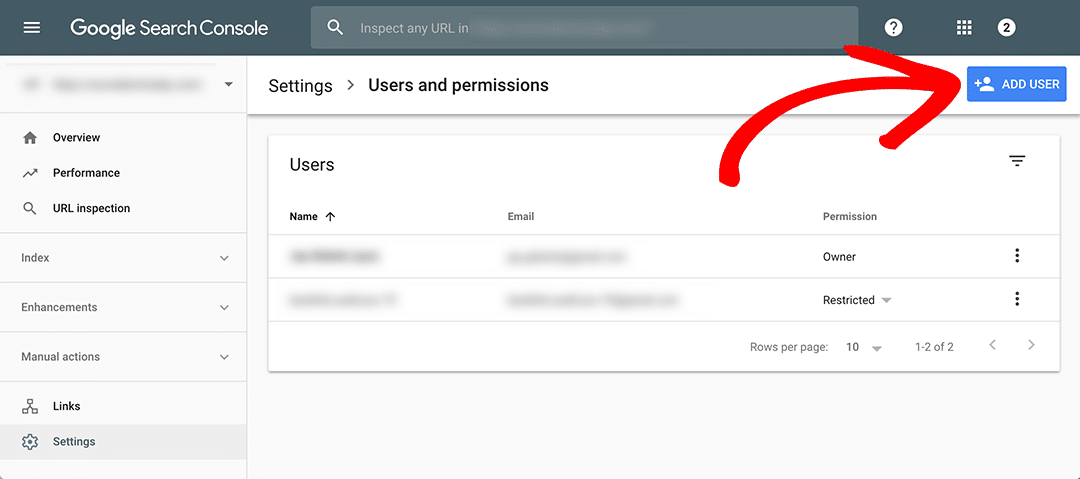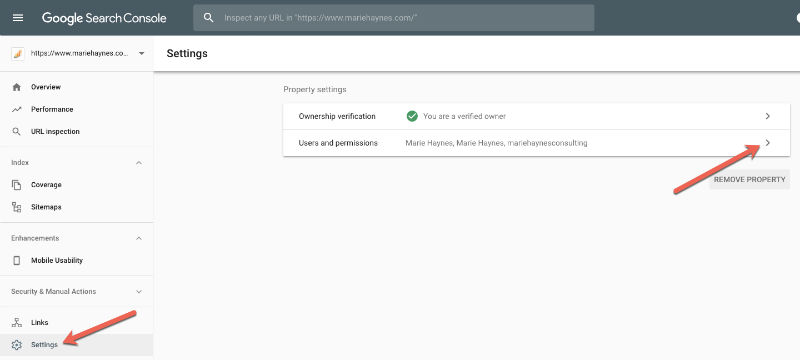


To add users to Google Search Console, navigate to the home dashboard & select the desired property. Click on the settings icon, then "Users & permissions." Click the "Add user" button, enter the new user’s email address, & select their permissions (Full or Restricted). Finally, click "Add" to complete the process. The invited user will receive an email notification, granting them access to the specified property within Google Search Console.
Add Users to Google Search Console: A Step-by-Step Guide. Learn how to add users to Google Search Console with this easy step-by-step guide. Enhance collaboration & boost your website's performance today!
Adding users to Google Search Console allows team members to manage website performance data. Google Search Console offers crucial insights into site visibility. Multiple users can benefit from analyzing search performance metrics. Each user can access the platform based on permissions. There are different roles, such as owner, full user, & restricted user. Each role grants specific access levels. Owners can manage settings, while full users can view & analyze most data. Restricted users have limited capabilities.
User management functions have seen significant improvements in Google Search Console. Initially, adding users was simpler, restricting control to one main account owner. Over time, feedback from users shaped enhancements in functionality. With updates, Google added layers of security & control. This evolution supports collaboration among digital marketing teams & webmasters. Newer versions now include concise management tools that facilitate user permissions. It encourages better workflows for website performance assessment & optimization.
Follow these practical steps for effective user addition. First, sign into your Google Search Console account. Next, select the property for which you wish to add users. Look for the "Settings" option in the left sidebar. Click on "Users & Permissions." This section shows current users & their roles. To add a new user, click on the “Add User” button. Enter the email address of the new user in the designated field. Choose an appropriate permission level from owner, full user, or restricted user. Finally, click "Add" to complete the process. A verification email will notify the new user, prompting them to access the account.
Incorporating multiple users into Google Search Console offers numerous advantages. Collaboration improves team efficiency, allowing members to handle various aspects of web management. Each contributor can analyze specific data segments, leading to diverse insights. This diversity enhances decision-making processes, influencing SEO strategies positively. Shared responsibilities result in timely updates on website performance metrics. And another thing, user roles facilitate tailored access, ensuring security & data integrity. Such an approach promotes a more inclusive environment for discussing improvements based on real-time analytics.
While adding users appears straightforward, certain challenges may arise. Permission errors often occur if the incorrect access level is assigned. It can lead to frustration for those unable to view necessary data. And another thing, some users may not receive verification emails, hindering their onboarding. Ensure that the correct email address is used to avoid this issue. If verification does not occur, check the spam folder or request another invite. Communicating effectively with team members about their roles can also minimize confusion.
Anticipated advancements in user management within Google Search Console focus on enhancing accessibility. With ongoing updates, Google will likely introduce new features that facilitate collaboration. Improved interface design may simplify user addition & role assignment. Enhanced security features could protect sensitive data even further. On top of that, expanded integration capabilities with other tools might emerge, fostering a seamless workflow among digital assets. Such progress will ensure that user management remains efficient & secure, adapting to evolving online needs.
| User Type | Permission Level |
|---|---|
| Owner | Full Control |
| Full User | Access to Most Features |
| Restricted User | Limited Access |
Managing user access effectively is key. - Emery Lueilwitz
| Problem | Solution |
|---|---|
| Incorrect Email Address | Double-check the email entered. |
| User Not Receiving Invitation | Ask the user to check spam folders. |
| User Access Issues | Review their permission levels. |

Google Search Console is a key tool for webmasters. It helps track your website's performance on Google. You can see how Google views your site. Adding users allows teams to collaborate, enhancing your site's management. This guide provides clear instructions on how to do this.
Using Google Search Console offers many benefits. First, it helps you see your site's visibility on Google. You can get alerts about issues with your site. Also, you can see how well your keywords are performing. It keeps you informed about site health.
These features create opportunities for better site management. Hence, using this tool is beneficial for business growth. It empowers users to make informed decisions based on data.
First, you must set up Google Search Console. Visit the Google Search Console website & sign in. You will need a Google account for this. After signing in, add your website by clicking the "Add Property" button. Input your site URL. Then, choose between two verification methods: domain or URL prefix. Follow the provided instructions & verify your ownership.
| Verification Method | Description |
|---|---|
| Domain | Verifies ownership for the entire domain. |
| URL Prefix | Verifies ownership for a specific URL. |
Successful verification grants access to Google Search Console. You can now manage your site. This step is crucial for adding users.
Now, let's focus on how to add users. After verifying your site, navigate to the Settings menu. You’ll find this in the bottom left corner. Click on “Users & Permissions.” This section shows current users & permissions.
To add a new user, click the “Add User” button. A pop-up will appear. Enter the user's email address. Choose the role: either Full or Restricted. Full access allows all features. Restricted access limits abilities.
| Role | Description |
|---|---|
| Full Access | Access to all features & settings. |
| Restricted Access | Limited features, no changing settings. |
After entering details, confirm by clicking “Add.” The user receives an email notification. They must accept this to access the Search Console.
Once you add users, it is essential to verify their access. A few days after sending invitations, check the user list in the “Users & Permissions” section. Ensure they appear as active users. If they do not, investigate possible issues.
Sometimes, users forget to accept invitations. Resending the invitation can solve this. A simple email follow-up can help too.
Managing user permissions is important. You can change a user's role at any time. To adjust permissions, go to the “Users & Permissions” section again. Locate the user’s name. Click on the three dots next to their name. Choose “Change permissions.” Select the new role & confirm.
Monitoring user activity promotes accountability. Only allow trusted individuals access. This approach protects your site's data.
If a user no longer needs access, you can remove them easily. In the “Users & Permissions” section, find the user’s name again. Click on the three dots next to their name & choose “Remove User.” This action will revoke all access immediately.
Consider informing the user before removing access. This practice helps maintain professionalism. Always keep an updated user list to enhance security.
Sometimes, users may face issues when adding new accounts. The most common issue is email verification. Ensure users check their spam folders for verification emails. Another issue is the wrong email address. Always confirm the email entered is correct before proceeding.
By troubleshooting these issues early, you can minimize delays in the user setup process.
Applying best practices ensures smooth operations. Regularly review user access. This helps you identify who needs access & who doesn't. Remove users who no longer work with you.
Keep a clear record of user permissions. Always have a backup of necessary information. This practice promotes organized management.
| Best Practices | Details |
|---|---|
| Regular Audits | Check user access every few months. |
| Clear Records | Document user roles & changes. |
These measures enhance security & stability. They protect your site's data & maintain integrity.
"Add Users to Google Search Console: A Step-by-Step Guide can significantly improve site management." Mittie D'Amore
After successfully adding users, you can focus on performance. Google Search Console offers tools to monitor metrics. Check how many visitors come from search results. Analyze the most popular pages on your site. You can identify issues like broken links & 404 errors.
Utilizing these insights improves user experience. Always communicate findings with your team. This ensures everyone works towards common goals.
Keeping track of user activity is essential. Use reports available in Google Search Console. They show how users interact with your site. You can analyze clicks & impressions over time. This data helps inform future decisions.
Sharing these reports with your team is crucial. Regular updates maintain transparency & encourage discussion about strategies. Team effort can enhance site optimization.
Collaboration among users in Google Search Console leads to better results. When multiple users contribute, the workload gets shared. Team efforts can uncover new insights, driving performance improvements from various angles.
Engage with each other regularly to discuss findings. This collaboration can lead to innovative solutions. Share responsibilities based on users' strengths for better effectiveness.
For additional information, several resources are available online. These can help supplement your knowledge about Google Search Console. Here are a few useful links:
Leverage these resources to grow your skills. Continuous learning benefits everyone involved. Enhancing your knowledge means better site management.
In my early days, I struggled with Google Search Console. Adding users felt overwhelming. Be that as it may, I practiced following guides similar to this one. Over time, it became easier. Now, I help others to navigate the process. Sharing knowledge is rewarding & fulfilling.

To add a user to Google Search Console, navigate to the property you want to manage. Click on the settings icon on the left sidebar, then select "Users & permissions". From there, click the "Add user" button to enter the email address & select the desired permission level.
You can assign two main permission levels: "Full" & "Restricted". Full permissions allow users to view & modify settings, while Restricted permissions limit users to viewing only specific data without making changes.
Yes, you can remove a user at any time. Go to "Users & permissions" from the settings menu, find the user you wish to remove, click on the three-dot menu next to their email, & select "Remove".
There is no specific limit on the number of users you can add to a property in Google Search Console. Be that as it may, it's best to only add those who need access to avoid unnecessary complications.
The user will need to create a Google account to gain access to Google Search Console. They can sign up for a Google account using any valid email address.
After adding a user, you can check the "Users & permissions" section to confirm that the new user's email appears in the list with the correct permission level.
Yes, you can change the permissions anytime. Go to the "Users & permissions" section, find the user, click on the three-dot menu next to their email, & select "Edit". You can then choose a different permission level.
Google Search Console does not provide direct reports on user activity. Be that as it may, you can monitor changes made by users in the property settings & performance reports over time.
While providing access to multiple users can be safe, ensure that each user understands their responsibilities & the importance of data integrity to minimize the risk of accidental changes.
If a user forgets their Google account password, they should follow the account recovery process provided by Google, which includes options for resetting the password through recovery email or phone number.
🎉 Biggest Black Friday Deal Ever!
MASSIVE 80% OFF
Unlock unlimited AI power across every plan.
Offer Ends In:
Ends December 10
Use Code: BLACKFRIDAY80